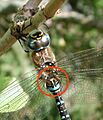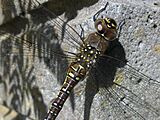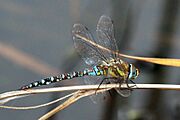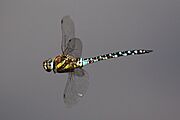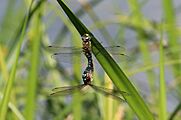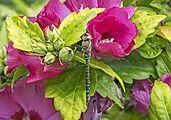Migrant hawker facts for kids
Quick facts for kids Migrant hawker |
|
|---|---|
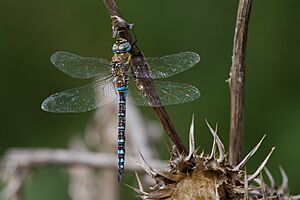 |
|
| Male | |
 |
|
| Female | |
| Scientific classification | |
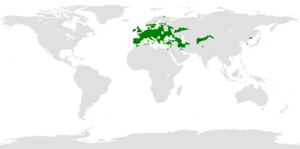 |
|
| Range of Aeshna mixta |
The migrant hawker (Aeshna mixta) is a type of dragonfly. It is one of the smaller hawker dragonflies you might see. Even though it needs water to lay its eggs, it can often be found flying far away from ponds or lakes. For breeding, it likes calm or slow-moving water, and it can even live in water that is a little bit salty (called brackish water). You can usually spot these dragonflies flying from July until the end of October. Migrant hawkers live in North Africa, southern and central Europe, and up to the Baltic region.
Contents
How to Identify a Migrant Hawker Dragonfly
The migrant hawker looks dark when it flies. It is similar to other dragonflies in the Aeshna group, but it has a special mark on its body. Look for a "golf-tee" shaped mark on the second part of its abdomen (its tail section). This mark helps you know it's a migrant hawker! When it's flying, it might look like a small Emperor dragonfly with a blue abdomen that curves downwards from the side.
It can be tricky to tell the migrant hawker apart from another dragonfly called A. affinis, especially if they are flying in the same area. But there's a trick! Look at the sides of their bodies, near their wings (this is called the thorax).
- In A. affinis, the sides of the thorax are yellowish-green with thin black lines.
- In the migrant hawker (A. mixta), the sides are also yellowish, but they have dark brown areas that make it look like there are two wide yellow stripes.
Where Migrant Hawkers Live and Their Habitat
You can find the migrant hawker across central and southern Europe, North Africa, the Middle East, and all the way across Asia to China and Japan. These dragonflies are known to travel a lot, so you might see them outside their usual homes. In recent years, they have been moving further north. For example, in the United Kingdom, they were rare until the 1940s. Then, many started flying over from mainland Europe. Now, they live and breed all over England and Wales. They even reached the Isle of Man in 1998 and Ireland in 2000.
Migrant hawkers lay their eggs in lakes and ponds. They can even live in water that is a little salty. You can also find them away from water, flying high among trees and bushes. They often rest low on plants. In 2011, one was even found near a park in Calgary, Canada!
Life Cycle and Behavior
You can see migrant hawkers flying during most months of the year, but they are most common from July to late October or early November. After they hatch and become adult dragonflies, they fly away from the water. During this time, they eat a lot and get ready to mate.
Unlike some other dragonflies, migrant hawkers don't usually claim a specific area as their own. You often see them eating or resting together in groups. Sometimes, they even form large swarms to catch food. They like to hang out around trees and bushes, often quite high up.
Once they are ready to mate, they fly back to the water. The males will fly around, looking for females. Migrant hawker males are not as protective of their territory as other types of hawker dragonflies. After mating, the male and female separate, and the female lays her eggs alone.
The eggs grow a little bit, then they go into a resting stage called "diapause." The migrant hawker spends the winter as an egg in this resting stage. In the spring, the eggs hatch into a tiny form called a "prolarva." This stage only lasts for a few seconds or minutes before it changes into a larva. The larvae grow quickly, and the adult dragonflies appear in the summer. This means the migrant hawker completes its entire life cycle in just one year!
See also
- Southern migrant hawker, another type of dragonfly found in southern Europe and Asia
 In Spanish: Aeshna mixta para niños
In Spanish: Aeshna mixta para niños


